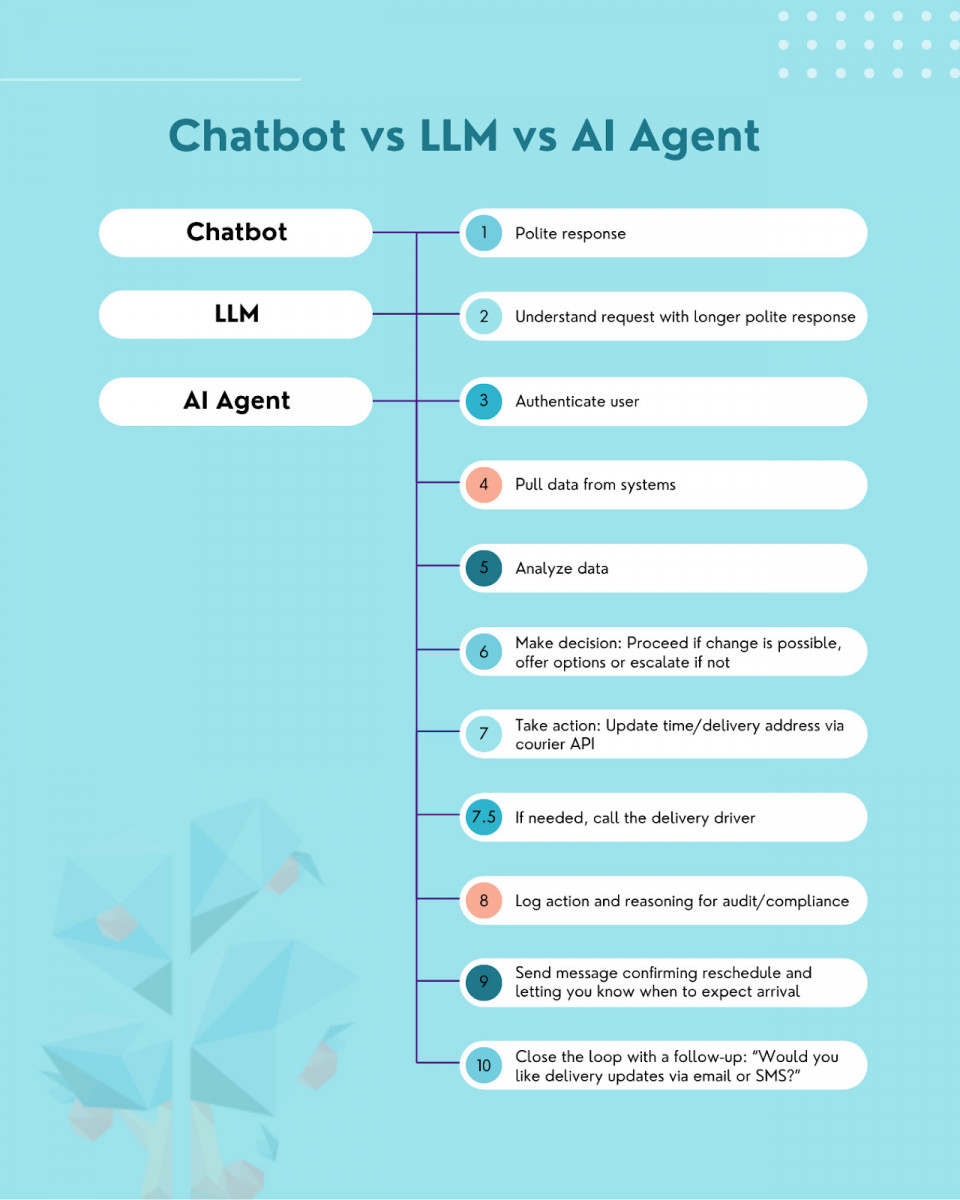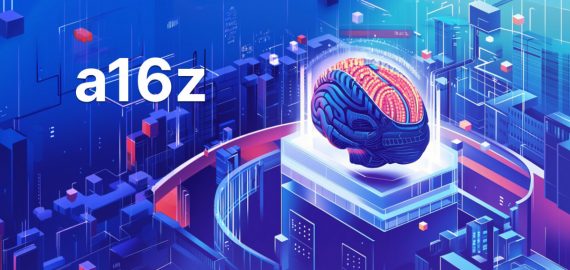AI Agents Are Not LLMs / Chatbots


In Brief
Chatbots are obsolete and LLMs alone aren’t enough — the future belongs to true AI agents that combine understanding, reasoning, and action to autonomously complete complex tasks across real-world systems.

In one year, the world will remember chatbots the way it remembers fax machines: an awkward step on the road to something better. Ask any COO about their chatbot rollout, and you will see the same polite shrug: “It’s clunky, it’s high maintenance, it fails at answering FAQs. We still need humans.”
We’ve all been there. You try to adjust the delivery time or address for an important parcel. A chatbot politely replies that it has taken note of your request and will now get a human customer support personnel to execute the logistics of it. It doesn’t take any other action beyond that. You feel frustrated.
Here’s the reality: the chatbot era is over. Enterprises that cling to it will bleed time, money, and talent. A new breed — autonomous AI agents — is stepping in, and the gulf between the two approaches will decide which companies sprint ahead and which stay trapped in customer-service purgatory.
How We Got Stuck with Zombie Chatbots
Early chatbots were supposed to be the frontline of automation. Instead, they became everyone’s least favorite customer experience. Why? Because they were never built to understand anything.
They were rule-based from the start. Hardcoded scripts, linear decision trees, “if this, then that” flows that explode in complexity quickly. Say the exact right phrase and they respond. Deviate even slightly, and you’re either ignored or looped back to the beginning. Like an IVR menu with better manners. The exponential branches are what make traditional chatbots impossible to maintain beyond 20 common use cases, let alone deliver ROI.
And the problem isn’t just bad UX — it’s architectural. Rules-based systems don’t generalize. They can only respond to predefined inputs and scenarios. The moment something changes — a policy update, new pricing tier, a customer asking a valid question slightly differently — the entire flow collapses.
What happens next? Escalation to humans. Again and again.
Meanwhile, frontline staff are stuck doing the same repetitive tasks the bot couldn’t finish — manually updating shipping records, calling the driver, logging the update — while the dashboard reports a “successful interaction.” Who is it really working for?
Today, most enterprise “AI chatbot” deployments are little more than glorified decision trees. Cosmetic improvements — friendlier tone, branded avatars — can’t change the underlying reality: they’re brittle, shallow, and get stuck easily.
But these bots were sold as silver bullets. So companies kept investing, hoping each new release would finally close the loop. It didn’t. It couldn’t. Because the architecture was never built for autonomous understanding or action — it was built to deflect tickets.
That’s why most chatbot KPIs are surface-level: CSAT, handoff rate, session length. The moment you ask, “Did it actually solve the problem?” the dashboards go quiet.
When you celebrate chatbot metrics, you are basically celebrating a treadmill for distance travelled. Simply put: lots of motion, nowhere to go.
Then Came the LLMs — Talkers, Not Doers
Enter GPT and its cousins. Suddenly, bots could hold conversations. They understood slang. They handled ambiguity. They remembered things and have a long context memory.
It felt like magic. And it was a genuine leap forward. For the first time, AI could generate human-like responses at scale. AI is intelligent.
But here’s the catch: LLMs are brilliant improvisers, not operators.
They don’t have structured goals. They don’t “know” when a task is complete. They can’t reliably access, update, or enforce business rules without scaffolding. What they produce is language — compelling, articulate, and occasionally useful, but rarely accountable.
When an LLM tells you it has submitted your request, it hasn’t. Unless it’s wrapped in an orchestration layer that bridges language to action, it’s still just talk.
So while LLMs moved the industry forward, they didn’t solve the execution gap. They created a new class of false expectations. Now, users aren’t just frustrated with bots — they’re confused by AI that sounds smart but can’t actually help.
That confusion is what leads us here: to AI workflows and AI agents.
What an AI Agent Really Is
An AI workflow is an LLM that executes commands with predetermined steps. But often in the real world, steps cannot be predicted beforehand.
That’s where AI agents come in. It’s an LLM that integrates with external tools, able to reason deeply, and — using everything it has access to — solves complex problems that would take humans orders of magnitude longer to do.
AI agents achieve this by combining all three layers.
First, a conversation layer that is often an LLM to interpret intent (yes, LLMs are useful, it’s just that calling an LLM an “AI solution” by default is like calling dial-up modems WiFi); second, a reasoning layer that outlines all the rules, policies, and task planning that decide what should happen; and third, an execution layer with secure connectors into CRMs, ERPs, payment rails, voice systems, and whatever legacy monster hides in the closet.
Remove any layer and the tower collapses. Keep them together and the system moves from “reply” to “resolve.”
Let’s revisit the scenario of the customer who needs to reroute a parcel.
Traditionally, chatbots can complete the first step — ticket handling. LLMs might get you one step further. Then a human needs to step in. They make decisions, then type replies manually. This is painful. Now an AI agent proactively executes entire workflows, makes autonomous decisions, interacts with backend systems, and logs activities for audit purposes, all without human intervention unless absolutely necessary.

Image credit: Jurin AI
The agent does in thirty seconds what would otherwise ping-pong across multiple departments. It owns the task, from start to finish.
So Let’s Stop Calling Everything an “Agent”
The term “AI agent” is having its moment — but like all good buzzwords, it’s being stretched thin. Every vendor with a chatbot and an API now claims to offer “agents.” Some even use the word just because their LLM remembers your name for five turns.
This misuse isn’t just branding fluff — it causes real confusion. It trains buyers to expect outcomes from tools that were never designed to deliver them. It slows down adoption by creating false expectations, followed by real disappointment. Worst of all, it lets enterprises convince themselves they’re innovating, when all they’ve done is bolt a new UI onto the same old service desk.
But the AI transformation is real.
True AI agents aren’t just more conversational. They’re more accountable. They integrate deeply, act responsibly, and deliver traceable, business-critical outcomes. They aren’t just an interface — they are infrastructure.
And we’re only at the beginning.
The Future of Information: From Apps to AI Agents
For years, we’ve adapted to the logic of machines. We’ve clicked through menus, memorized interfaces, juggled five tabs just to complete a task. Search got smarter, apps got sleeker — but the burden stayed on the user.
AI agents flip that.
Instead of asking you to learn how the system works, the system learns how you work — through natural conversation.
Want to book your travel? Just chat with your private AI concierge:
“Plan a hiking trip in the Alps, early September, off the beaten path.”
And it happens. Flights, hotels, local guides — even hidden gems you would never have discovered on your own. No 90s websites or clunky mobile apps with bad UX. Just a conversation that gets things done.
This is a shift from apps you operate to agents that operate on your behalf.
And it won’t stop at travel. Agents will reshape how we interact with everything — logistics, procurement, compliance, HR. Quietly transforming brittle tools and fragmented workflows with intelligent systems that can reason, act, and improve over time.
This is the agentic future: where tasks are completed instantly via voice or text by AI that understands, acts, and delivers — your very own executive assistant.
It’s not a sci-fi vision. It’s just one to two years away. And we’re already building toward it at Jurin AI.
The age of agentic AI is here, and we’ve only scratched the surface. I’ve never been more excited.
Disclaimer
In line with the Trust Project guidelines, please note that the information provided on this page is not intended to be and should not be interpreted as legal, tax, investment, financial, or any other form of advice. It is important to only invest what you can afford to lose and to seek independent financial advice if you have any doubts. For further information, we suggest referring to the terms and conditions as well as the help and support pages provided by the issuer or advertiser. MetaversePost is committed to accurate, unbiased reporting, but market conditions are subject to change without notice.
About The Author
Rise Ooi is a three-time tech founder, engineer, and investor known for identifying billion-dollar opportunities early. He helped scale Applied Intuition into a multi-billion-dollar unicorn by building its Asian presence from the ground up and now leads Jurin AI, where he’s assembling a world-class team to reshape workplace productivity across Asia-Pacific. A former AI scientist at Japan’s national labs, Rise brings deep technical and global expertise to everything he builds.
More articles

Rise Ooi is a three-time tech founder, engineer, and investor known for identifying billion-dollar opportunities early. He helped scale Applied Intuition into a multi-billion-dollar unicorn by building its Asian presence from the ground up and now leads Jurin AI, where he’s assembling a world-class team to reshape workplace productivity across Asia-Pacific. A former AI scientist at Japan’s national labs, Rise brings deep technical and global expertise to everything he builds.

















































